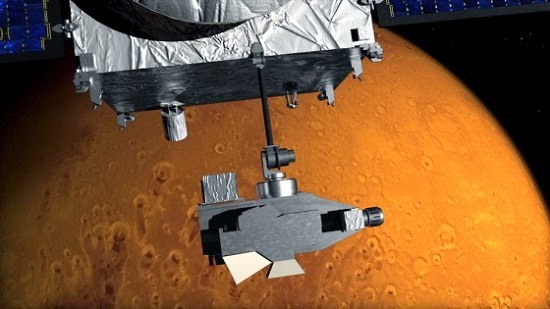The Maven probe has landed on Mars. We will unveil the past of the red planet
After a journey of 10 months, went into orbit around the red planet. It 'the first mission dedicated entirely to the atmosphere of Mars and will help us understand why it became a planet so dry and desert.
There is a new eye on Mars. And 'one of the Mars Atmosphere and Volatile Evolution (Maven), the new NASA probe that has just come into orbit around the red planet. But unlike other previous missions, Maven will not take care to study the surface of Mars, but the outer regions of its atmosphere. Great satisfaction to NASA for the final stages of maneuver that led the probe into orbit at 4:30 am Italian. After a journey of about ten months, the probe is ready to begin scientific observations, which will start officially after six weeks of testing tools. Maven is the first spacecraft dedicated entirely to the study of the Martian atmosphere, and the data collected will be of great importance to better understand the red planet. The study of the atmosphere in fact help to shed light on climate change in the past led Mars to be the arid planet we know today.
Martian climates. Previous missions have in fact shown that the Martian climate has changed dramatically over time. For example, the morphology of many impact craters suggests that the soil contained water at the time of their creation, and similar conclusions can be reached from the study of the rate of erosion of various geological formations on the surface. The presence of valleys and canyons is also a strong indication that in the past the water flowed on the surface, as confirmed by some minerals found recently on the Martian surface. Still, a Martian landscape covered with water belongs to the distant past of at least 4 billion years ago.
Today, Mars has a very different aspect: it is a barren desert planet, where the average temperature is around -60 ° C, and that the poles can drop to -153 ° C. Why is the Martian climate has changed so much? The atmosphere must have played a fundamental role, becoming thinner and thinner. The observations indicate that today the mean atmospheric pressure on Mars is less than 1% of what we have here on Earth at sea level. It is not clear why the atmosphere has changed, and scientists suspect that it was critical interaction with the solar wind, the powerful "wind" of high-energy particles emitted by the Sun. "The scientific mission of Maven focuses on answering questions about where she went the water was once present on Mars, and where she is carbon dioxide, "said the head of Maven Bruce Jakosky, University of Colorado in Boulder. "These are important questions for understanding the history of Mars, its climate and its potential to support at least microbial life"
Eyes on the atmosphere. To study the outer regions of the Martian atmosphere, including the ionosphere, will be the main task of Maven. Launched in November last year, the probe has come in ten months, a journey of about 700 million kilometers. The placing in orbit maneuvers were coordinated by the team of Lockheed Martin Space Systems in Littleton, Colorado. One of the most important steps was the lighting of the six engines, which have slowed down in about half an hour allowing you to insert the probe into orbit capture with a period of 35 hours. Now, the probe has entered the so-called commissioning phase, six weeks during which the scientific instruments will be tested. They will also be applied to small corrections in order to reach the final orbit, which will have a period of 4 hours and a half and will be very elliptical. In this way, at its point of closest approach the probe "will rise" the planet at an altitude of 93 km, that is, entering directly to the outside atmosphere and measuring the composition. In the farthest point of the orbit the probe will at a distance of about 6000 km, from which the tools will be able to conduct observations of the planet.
The spacecraft carries three sets of instruments. The first, called Particles and Fields Package (PFP), was carried out under the supervision of the University of Berkeley and includes six instruments devoted to the analysis of the Martian ionosphere and the solar wind. Then there is the Remote Sensing Package, built by the University of Boulder in Colours, which will determine the overall characteristics of the Martian outer. Finally, the Neutral Gas and Ion Mass Spectrometer, built at NASA's Goddard Space Center, will measure the composition of the Martian atmosphere. "Maven is another science mission of NASA's robotic exploration that opens the way to our trip to Mars," said Jim Green, director of NASA's planetary science division. Because if we imagine our future on Mars, we must first learn to unravel its secrets.



Comments
Post a Comment